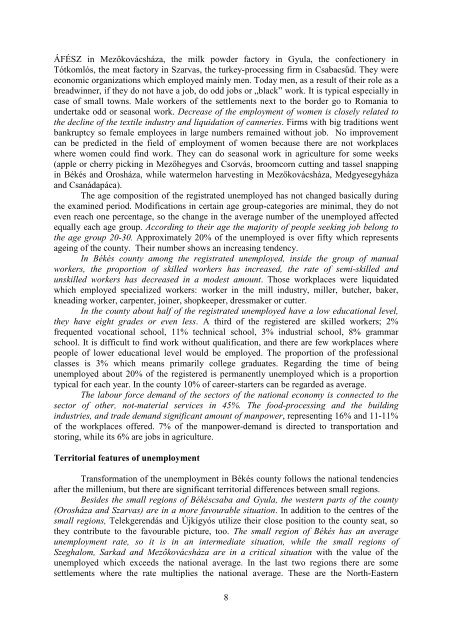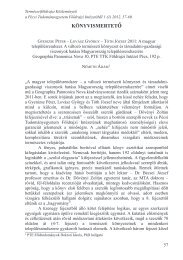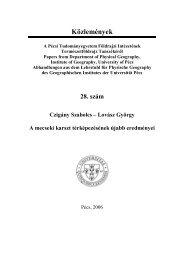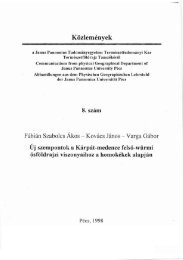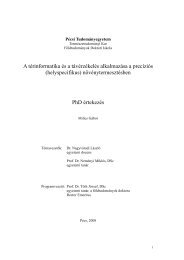ÁFÉSZ <strong>in</strong> Mezıkovácsháza, <strong>the</strong> milk powder factory <strong>in</strong> Gyula, <strong>the</strong> confectionery <strong>in</strong>Tótkomlós, <strong>the</strong> meat factory <strong>in</strong> Szarvas, <strong>the</strong> turkey-process<strong>in</strong>g firm <strong>in</strong> Csabacsőd. They wereeconomic organizations which employed ma<strong>in</strong>ly men. Today men, as a result of <strong>the</strong>ir role as abreadw<strong>in</strong>ner, if <strong>the</strong>y do not have a job, do odd jobs or „black” work. It is typical especially <strong>in</strong>case of small towns. Male workers of <strong>the</strong> settlements next to <strong>the</strong> border go to Romania toundertake odd or seasonal work. Decrease of <strong>the</strong> employment of women is closely related to<strong>the</strong> decl<strong>in</strong>e of <strong>the</strong> textile <strong>in</strong>dustry and liquidation of canneries. Firms with big traditions wentbankruptcy so female employees <strong>in</strong> large numbers rema<strong>in</strong>ed without job. No improvementcan be predicted <strong>in</strong> <strong>the</strong> field of employment of women because <strong>the</strong>re are not workplaceswhere women could f<strong>in</strong>d work. They can do seasonal work <strong>in</strong> agriculture for some weeks(apple or cherry pick<strong>in</strong>g <strong>in</strong> Mezıhegyes and Csorvás, broomcorn cutt<strong>in</strong>g and tassel snapp<strong>in</strong>g<strong>in</strong> Békés and Orosháza, while watermelon harvest<strong>in</strong>g <strong>in</strong> Mezıkovácsháza, Medgyesegyházaand Csanádapáca).The age composition of <strong>the</strong> registrated unemployed has not changed basically dur<strong>in</strong>g<strong>the</strong> exam<strong>in</strong>ed period. Modifications <strong>in</strong> certa<strong>in</strong> age group-categories are m<strong>in</strong>imal, <strong>the</strong>y do noteven reach one percentage, so <strong>the</strong> change <strong>in</strong> <strong>the</strong> average number of <strong>the</strong> unemployed affectedequally each age group. Accord<strong>in</strong>g to <strong>the</strong>ir age <strong>the</strong> majority of people seek<strong>in</strong>g job belong to<strong>the</strong> age group 20-30. Approximately 20% of <strong>the</strong> unemployed is over fifty which representsage<strong>in</strong>g of <strong>the</strong> county. Their number shows an <strong>in</strong>creas<strong>in</strong>g tendency.In Békés county among <strong>the</strong> registrated unemployed, <strong>in</strong>side <strong>the</strong> group of manualworkers, <strong>the</strong> proportion of skilled workers has <strong>in</strong>creased, <strong>the</strong> rate of semi-skilled andunskilled workers has decreased <strong>in</strong> a modest amount. Those workplaces were liquidatedwhich employed specialized workers: worker <strong>in</strong> <strong>the</strong> mill <strong>in</strong>dustry, miller, butcher, baker,knead<strong>in</strong>g worker, carpenter, jo<strong>in</strong>er, shopkeeper, dressmaker or cutter.In <strong>the</strong> county about half of <strong>the</strong> registrated unemployed have a low educational level,<strong>the</strong>y have eight grades or even less. A third of <strong>the</strong> registered are skilled workers; 2%frequented vocational school, 11% technical school, 3% <strong>in</strong>dustrial school, 8% grammarschool. It is difficult to f<strong>in</strong>d work without qualification, and <strong>the</strong>re are few workplaces wherepeople of lower educational level would be employed. The proportion of <strong>the</strong> professionalclasses is 3% which means primarily college graduates. Regard<strong>in</strong>g <strong>the</strong> time of be<strong>in</strong>gunemployed about 20% of <strong>the</strong> registered is permanently unemployed which is a proportiontypical for each year. In <strong>the</strong> county 10% of career-starters can be regarded as average.The labour force demand of <strong>the</strong> sectors of <strong>the</strong> national economy is connected to <strong>the</strong>sector of o<strong>the</strong>r, not-material services <strong>in</strong> 45%. The food-process<strong>in</strong>g and <strong>the</strong> build<strong>in</strong>g<strong>in</strong>dustries, and trade demand significant amount of manpower, represent<strong>in</strong>g 16% and 11-11%of <strong>the</strong> workplaces offered. 7% of <strong>the</strong> manpower-demand is directed to transportation andstor<strong>in</strong>g, while its 6% are jobs <strong>in</strong> agriculture.Territorial features of unemploymentTransformation of <strong>the</strong> unemployment <strong>in</strong> Békés county follows <strong>the</strong> national tendenciesafter <strong>the</strong> millenium, but <strong>the</strong>re are significant territorial differences between small regions.Besides <strong>the</strong> small regions of Békéscsaba and Gyula, <strong>the</strong> western parts of <strong>the</strong> county(Orosháza and Szarvas) are <strong>in</strong> a more favourable situation. In addition to <strong>the</strong> centres of <strong>the</strong>small regions, Telekgerendás and Újkígyós utilize <strong>the</strong>ir close position to <strong>the</strong> county seat, so<strong>the</strong>y contribute to <strong>the</strong> favourable picture, too. The small region of Békés has an averageunemployment rate, so it is <strong>in</strong> an <strong>in</strong>termediate situation, while <strong>the</strong> small regions ofSzeghalom, Sarkad and Mezıkovácsháza are <strong>in</strong> a critical situation with <strong>the</strong> value of <strong>the</strong>unemployed which exceeds <strong>the</strong> national average. In <strong>the</strong> last two regions <strong>the</strong>re are somesettlements where <strong>the</strong> rate multiplies <strong>the</strong> national average. These are <strong>the</strong> North-Eastern8
settlements of <strong>the</strong> small region of Sarkad: Körösnagyharsány, Zsadány, Geszt, Mezıgyán andÚjszalonta, also <strong>in</strong> <strong>the</strong> Eastern part of <strong>the</strong> region of Mezıkovácsháza: Nagykamarás,Almáskamarás, Dombiratos and Pusztaottlaka.Although <strong>the</strong>re were examples to enlarge employment <strong>in</strong> <strong>the</strong> small regions with morefavourable positions but <strong>the</strong> decrease of food and textile <strong>in</strong>dustries affected <strong>the</strong>se regions, too.Negative changes could be seen <strong>in</strong> <strong>the</strong> sugar-, pig-, poultry and milk-process<strong>in</strong>g sectors <strong>in</strong> <strong>the</strong>small region of Gyula, while <strong>the</strong> textile branch has almost completely ceased to exist.Adm<strong>in</strong>istrative transformation, modernization is still <strong>in</strong> process which will result <strong>in</strong> reductionofmanpower. Reduction with more than 400 workers at <strong>the</strong> meat comb<strong>in</strong>ate affected <strong>the</strong>labour market of <strong>the</strong> region more significantly. There was a bigger <strong>in</strong>vestment only <strong>in</strong> <strong>the</strong> fieldof trade. Although shopp<strong>in</strong>g centres with more labour force demand have been built, smallershops closed down <strong>in</strong>creas<strong>in</strong>g <strong>the</strong> number of <strong>the</strong> unemployed. The <strong>in</strong>sufficient development of<strong>the</strong> <strong>in</strong>frastructure of <strong>the</strong> exam<strong>in</strong>ed area (low capacity of <strong>the</strong> ma<strong>in</strong> road 44), <strong>in</strong>crease of <strong>the</strong>wage costs and of <strong>the</strong> different taxes <strong>in</strong> case of enterprises, <strong>the</strong> cheap, foreign (Romanian,Ukra<strong>in</strong>ian, Bulgarian) manpower, decrease of <strong>the</strong> suppliers’ activity significantly contributedto <strong>the</strong> negative tendencies <strong>in</strong> <strong>the</strong> labour market. Territorial change <strong>in</strong> <strong>the</strong> employment rate isacceptable only <strong>in</strong> <strong>the</strong> small region of Békéscsaba, it exceeds here 50%, while it is only 35,8%<strong>in</strong> <strong>the</strong> most backward region, around Sarkad. The reasons for it: <strong>in</strong>frastructural developmentof <strong>the</strong> county head, manpower with more sufficient skills. Bad accessibility of <strong>the</strong> periphericalregions, <strong>the</strong>ir human sources with lower skills are serious obstacles. That is why <strong>in</strong>vestorswith <strong>the</strong> aim of job generation do not come to <strong>the</strong>se regions. Relatively good positions ofsmall regions realiz<strong>in</strong>g <strong>in</strong>termediate values (Szarvas, Gyula, Orosháza) are due to <strong>the</strong>ir<strong>in</strong>dustrial traditions.Staff work force reduction <strong>in</strong> case of big employers and <strong>the</strong> futurelessness of <strong>the</strong> food<strong>in</strong>dustry (Merián Rt.) are typical for <strong>the</strong> small region of Orosháza, too. Ano<strong>the</strong>r problem isthat <strong>the</strong> region can nei<strong>the</strong>r reta<strong>in</strong> nor attract <strong>the</strong> skilled manpower <strong>in</strong> <strong>the</strong> qualified sphere ofactivity. In <strong>the</strong> last years new <strong>in</strong>vestors did not settle <strong>in</strong> <strong>the</strong> <strong>in</strong>dustrial park. However, <strong>in</strong> <strong>the</strong>centre of <strong>the</strong> small region <strong>the</strong>re have been improvements, <strong>in</strong>vestments which can give <strong>the</strong>chance for a future optimism. It is for example, Gyopárosfürdı which is a bath complex ofregional importance with varied offer and <strong>in</strong>vestments <strong>in</strong> <strong>the</strong> build<strong>in</strong>g <strong>in</strong>dustry connect<strong>in</strong>g totourism (Gyopár Club Hotel and Conference Centre). One of <strong>the</strong> most <strong>in</strong>dustrialized town of<strong>the</strong> county, which has <strong>the</strong> biggest production and <strong>in</strong>vestment value, plays a role role <strong>in</strong> <strong>the</strong>region not only from <strong>the</strong> po<strong>in</strong>t of view of public adm<strong>in</strong>istration but of its favourable <strong>in</strong>dustrialstructure, as well. Orosháza is <strong>the</strong> favourite target for foreign <strong>in</strong>vestments.The small region of Szeghalom belongs to <strong>the</strong> regions with unfavourable locationwhere <strong>the</strong> ma<strong>in</strong> reason for <strong>the</strong> negative tendencies is <strong>the</strong> crisis of <strong>the</strong> textile and metal<strong>in</strong>dustries (Eurotex, Ikarus etc.) both <strong>in</strong> <strong>the</strong> region seat and <strong>in</strong> Füzesgyarmat. Producers cannotachieve <strong>the</strong> high quality requirements with out-of-date mach<strong>in</strong>es and skills. On <strong>the</strong> o<strong>the</strong>r hand<strong>the</strong>y do not have enough capital for <strong>the</strong> moderniz<strong>in</strong>g <strong>in</strong>vestments. Only a few enterprisesreach <strong>the</strong> export level, <strong>the</strong>re is not enough production with high technology and <strong>the</strong> measureof development is very low. The region is deficient <strong>in</strong> funds and not sensitive enough for <strong>the</strong><strong>in</strong>vestments.However, <strong>the</strong> lack of quality <strong>in</strong> <strong>in</strong>frastructure is typical for this area, too. Because of<strong>the</strong> bad condition of roads a lot of enterprises prefer premises where <strong>the</strong> safe transportationcan be guaranteed. Migration is significant because of <strong>the</strong> attractive force of <strong>the</strong> moredeveloped regions, <strong>the</strong> number of people with sufficient and modern qualifications is gett<strong>in</strong>gless and less among those who stayed <strong>in</strong> <strong>the</strong> region. Besides <strong>the</strong> lack of <strong>the</strong> skilled workers <strong>the</strong>lack of mobility, <strong>in</strong> vocational sense, makes <strong>the</strong> situation even worse.In <strong>the</strong> small region of Mezıkovácsháza <strong>the</strong> deepest economic-social crisis hasdeveloped which is anyway, one of <strong>the</strong> most fertile land of <strong>the</strong> country. After <strong>the</strong>9


